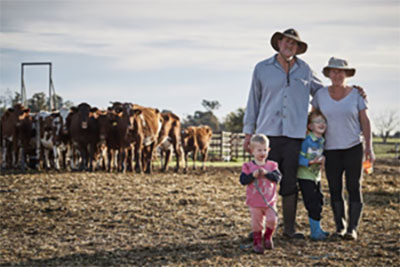Life on the West Island - Poor farmers?
04 April 2024

For many decades, there has been a common belief that West Island farmers are hardworking toilers who are doing it tough, even though the country relies on them for its food. But is that an accurate picture?
Writing in The Guardian recently, Gabrielle Chan, a freelance journalist and a farmer for more than 30 years, reported that rural life on the West Island has changed dramatically in the past three decades:
When I moved to the farm in the 1990s, regional economies were collapsing. It was about the same time as a young politician called Pauline Hanson was causing a stir and farmers were being whipped into hysteria in the post-Mabo phase.
Rural Australia was singing sad songs of hard times. Financial reforms were in full swing, tariff protections that shielded regional economies were collapsing, and the national wool stockpile was growing as sheep numbers fell and farmers walked away.
The loss of manufacturing and the rise of service industries were causing painful contractions in country and city areas. Rural kids were heading to the capitals to get a degree and fatter pay packets than they could get in their home towns.
In the 30 years since, the economic picture of regional Australia has changed markedly. While everyone talks about capital city housing prices and the rental squeeze, there’s a quiet real estate story outside the cities. And now that agriculture has recovered, maybe the focus should shift to towns.
This month, the Australian Bureau of Agricultural and Resource Economics and Sciences (Abares) released its Farmland Price Indicator, which showed the average price per hectare has increased by more than 130% since 2013. That more than doubling in the past 10 years is on par with Sydney growth rates. In 1994, broadacre farmland prices were $1,197 per hectare. By 2014, prices had climbed to $4,088 per hectare before it really accelerated to $9,429 by 2023.
Apart from a slight plateau in the past year, the growth in capital values is akin to the expectations set on reality TV show The Block, which popularised flipping properties as a way to make big money in Australia. At the same time, the slow but steady drop in the number of farm businesses that began in the 1980s has bottomed out. Fewer farms are changing hands and those that do are much more expensive.
Abares chief, Jared Greenville, painted two scenarios when we spoke last week. Either the high price of farmland means there are fewer buyers around, or agriculture has been through the consolidation phase and flattened out.
“This whole farm consolidation that has been occurring in broadacre agriculture has started to slow down,” he said. “It’s less small farms exiting the industry. So there’ll be less transactions going forward.”
At the same time, the Covid pandemic sparked a reverse Grapes of Wrath: instead of leaving the country to find work, people were leaving the city to find space and a lower mortgage payment.
Migration to the regions continues to hold, albeit at a lower level than in the lockdown highs. It is largely millennials who continue to move out of capital cities, pushed by housing affordability and pulled by lifestyle factors and more mobile working conditions.
In January, analysis by Core Logic found regional housing prices have fared better than cities, particularly for those towns within commuting distance of the capitals. In practical terms, that means some people are moving in, a feat most little town progress associations have been trying to achieve for decades. In other cases, it means people have bought a second house and have either left it empty for most of the year or are renting it out on platforms such as Airbnb. (In my town of 2,000, there is now one house to rent long-term and 10 listed on Airbnb.)
All these changes may amount to a subtle shift in the economies of regional Australia – one which will require a new narrative to replace the current default best typified by Hanrahan’s “we'll all be rooned”.
Big trends such as increasing global food demand have driven up commodity prices and encouraged better terms of trade, and that has favoured regional Australia in the past few years – even though global heating continues to play merry hell with weather-dependent businesses.
Because here’s the thing: most farmers have high equity because they know they need to build in fat for shocks and, frankly, banks are more gun-shy to lend. On 2022 figures, equity ratios for broadacre farms range between 98% for the smallest farms to 86% for the largest farms. The average mortgage holder would be happy with those numbers. Capital ranged from $3m to $33m across broadacre according to Abares on 2022 data.
Australian farmers collectively hold close to $6bn on farm management deposits, as of February 2024, to smooth out the rough seasons. Consistent research also shows Australian farmers have higher wealth than the average Australian household.
I am not downplaying the challenges, which I have pondered more extensively than your average journalist and by which I’m directly affected. It is true that large gaps still exist between rich and poor in the regions, including among farmers. But as the painful reforms of agriculture subside, I am reminded of Bob Dylan’s lyrics urging me to “pause in life’s pleasures and count its many tears”.
The next wicked problems, such as credible emissions abatement and growing food in a hotter world, are waiting. But I reckon farmers have had the lion’s share of political attention in the past 40 years of structural adjustment.
Chan’s analysis indicates that the focus of poverty in country West Island is now regional towns, which are plagued by challenges such as increased numbers of people sleeping rough, slow or missing disaster relief, patchy health services and substandard educational facilities. Regional town residents rarely have the resources of farmers – perhaps it’s time they received more government and community attention.